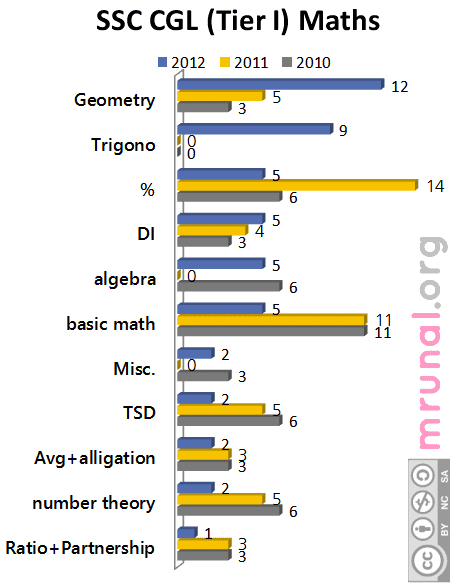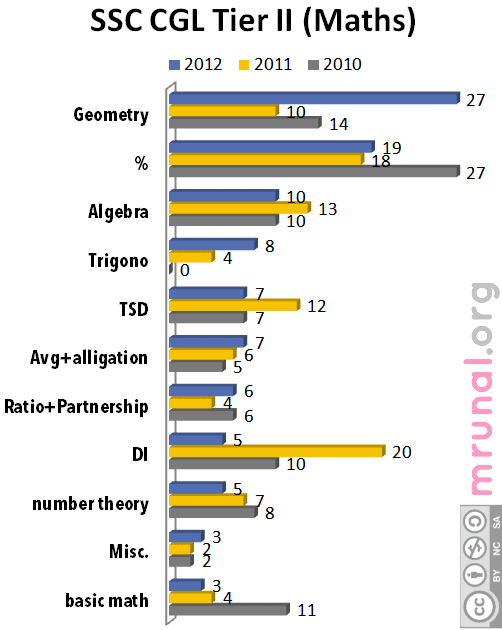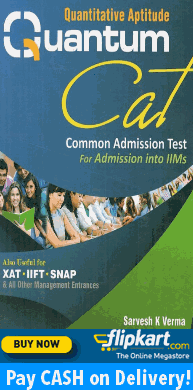- Introduction
- #1: Getting the conceptual clarity
- Breakup: SSC-CGL Tier I (2010, 2011, 2012)
- Breakup: SSC-CGL Tier II (2010, 2011, 2012)
- #2: Practice
- Choice of Quantitative Aptitude Book?
- Books for Maths/Quantitative Aptitude
- Download: NCERT Maths Textbooks
- Download: Blank answersheet
introduction
Competitive exams are meant for real-men and women. This is no country for crybabies, kids, college teens and no0bs. So first of all, you must get rid of the following “loser” mindsets:
- Yaar this maths is so hard, I can’t do it.
- I’m not from science/engineering background hence this is not my cup of tea.
- I’m poor in maths and I cannot improve.
- Thik hai, dekh lenge. (alright, I’ll see).
- Maths is not difficult. All it requires is concept clarity + lot of practice. In SSC-CGL exam, you’ve to face Mathematics at two stages
| Stage | Maths-Questions | Penalty |
| Tier-I (Prelims) | 50 Qs | Negative 0.25 |
| Tier-II (Mains) Paper I: Arithmetical Ability | 100 Qs worth 200 marks | Negative 0.50 |
- The Approach for Maths, stands on two pillars.
Pillars |
How? |
|
|
|
|
#1: Getting the conceptual clarity
- We’ll divide Maths or Quantitative Aptitude, into topics and further into subtopics.
- Your task is to cover one topic at a time, first get conceptual-clarity and then solve maximum questions at home.
- Whenever you learn any shortcut technique, you note it down in your diary.
- Similarly, whenever you make any mistake while solving sums, you also note that down in your diary. Night before the exam, you review that diary of mistakes. (why do this? Because it is the “Art of Aptitude” (Click ME)
| Topic | Subtopics | How to approach |
Number theory |
|
|
Basic Maths |
|
|
|
|
|
|
|
|
Algebra |
|
|
|
|
|
Avg and Ratios |
|
Can be solved without formula. Go through https://mrunal.org/2012/03/aptitude-alligationsmixturesalloys.html |
|
Lolz | |
|
For ratio-proportion NCERT Class 8 Chap 13. | |
|
https://mrunal.org/2012/05/aptitude-partnership-and-profit-sharing.html | |
STD |
|
All of them can be solved with just one Universal STD formula. Explained in www.Mrunal.org/aptitude |
Geometry |
|
|
|
|
|
|
Understand basics from NCERT Class 10 Chap 8 and 9. Then exam-oriented concepts from your Quantitative Aptitude book. | |
% |
|
Also do NCERT Class 8 Chap 8. |
|
Mere extention of % concept. Just practice. For long division, use this approximation method: https://mrunal.org/2012/11/aptitude-long-division-two-digit-division-calculation-without-tears-and-without-boring-vedic-speed-maths.html |
|
| Profit, loss, discount, marked price. | https://mrunal.org/2012/11/aptitude-concepts-of-marked-price-and-successive-discounts-profit-loss-without-stupid-formulas.html | |
| Simple and compound interest rate | https://mrunal.org/2012/04/aptitude-compound-interest-rate.html | |
PCP |
|
|
Misc. |
|
|
|
|
|
|
Not asked. |
Breakup: SSC-CGL Tier I (2010, 2011, 2012)
| Topic | 2010 | 2011 | 2012 |
|---|---|---|---|
| Ratio+Partnership | 3 | 3 | 1 |
| number theory | 6 | 5 | 2 |
| Avg+alligation | 3 | 3 | 2 |
| TSD | 6 | 5 | 2 |
| Misc. | 3 | 0 | 2 |
| basic math | 11 | 11 | 5 |
| algebra | 6 | 0 | 5 |
| DI | 3 | 4 | 5 |
| % | 6 | 14 | 5 |
| Trigonometry | 0 | 0 | 9 |
| Geometry | 3 | 5 | 12 |
| Total | 50 | 50 | 50 |
The 2012’s Tier-I paper, is “trend-breaker”. Because
- The conventional questions from ratio-proportion, basic maths, time-speed-work are asked for namesake only.
- Otherwise, Out of 50 Maths questions in tier-I, almost 30 questions are from just Geometry+Trig+Percentage application.
- Earlier, they used to ask mostly area-volume-perimeter type questions from Geometry segment. You just had to plug-in values into the formulas and get the answer.
- But This 2012’s paper has mostly theory based geometry (angle, bisector, tangent, inequality of triangles etc.)
- Similarly the difficulty level of algebra, number theory based questions is bit raised.
Or perhaps SSC too decided to employ the BackbreakingTM move of UPSC! Anyways, jokes apart, the lesson here is, “adapt.”
Breakup: SSC-CGL Tier II (2010, 2011, 2012)
| Type | 2010 | 2011 | 2012 |
|---|---|---|---|
| basic math | 11 | 4 | 3 |
| Misc. | 2 | 2 | 3 |
| number theory | 8 | 7 | 5 |
| DI | 10 | 20 | 5 |
| Ratio+Partnership | 6 | 4 | 6 |
| Avg+alligation | 5 | 6 | 7 |
| TSD | 7 | 12 | 7 |
| Trigonometry | 0 | 4 | 8 |
| Algebra | 10 | 13 | 10 |
| % | 27 | 18 | 19 |
| Geometry | 14 | 10 | 27 |
| Total | 100 | 100 | 100 |
- Here too, Geometry+Trigonometry have been given emphasis like never before.
- Almost 65% of the paper is made up of Geometry, Trig, Percentage and Algebra (and in that too, mostly Quadratic equations.)
#2: Practice
- Merely knowing the concepts or formulas won’t help. Because unless you practice different variety of questions, you won’t become proficient in applying those concepts flawlessly in the actual-exam.
- Second, despite knowing concept and formulas, people make silly mistakes either in calculation or in pluging the values.
- Third reason- Tier I has 200 questions in 120 limits. =not even 2 minutes per question. Plus, questions reasoning and comprehension might take more than 5 minutes! Therefore speed is essential. Since there is negative marking system, accuracy also matters.
- So it is beyond doubt that you have to practice excimer number of questions at home.
- The question is where to get the practice? Which book should be used for SSC exam?
Choice of Quantitative Aptitude Book?
- In all competitive exams, “uncertainity factor” is involved. Despite your best preparation, you might lose the success-train by 2-3 marks.
- Therefore you must never put all eggs in one basket.
- While you are preparing for SSC, you should also keep open mind and apply for other competitive exams, such as IBPS, ACIO, ONGC, Railways, LIC, CDS, Coast Guard etc. (Depending on your career-taste).
- Publication houses will come up with new books for each and every of ^these exams, but we have neither the time nor the money to buy a new book for every new exam.
- Such readymade books are only skimmed down version of original topicbooks. For example, if there is SSC-FCI exam, or ACIO exam, these people will combine a few topics of GK, maths, reasoning and english. And present you a book.
- Problem= you don’t get comprehensive understanding or coverage. Besides, given the population of India, competition level is always high, irrespective of exam. So half-hearted preparations with readymade “condensed” books don’t help much.
Almost all of these exams follow same structure:
- General awareness
- Maths
- Reasoning (Verbal, Non-Verbal)
- English vocabularly, grammar and comprehension.
- How do they differ from each other?= number of questions, difficulty level and inclusion / exclusion of particular subtopics.
- So when you’re picking up books for the first time, you should choose the books, that have universal usefulness for similar exams. That way your time, effort and money will be saved.
Books for Maths/Quantitative Aptitude
DONOT use Quantitative Aptitude by R.S.Agarwal for SSC-CGL.
Problems with RS Agarwal’s Math book:
- The way SSC-CGL question pattern is transforming, R.S.Agarwal’s book on Quantitative aptitude, is just not ‘upto the mark’ to match this changing environment.
- Its chapter on Trigonometry (Height and Distance) is simply insufficient to handle SSC-CGL level bombarding.
- Similarly coverage of algebra, quadratic equations and number theory is either absent or just for namesake.
- Geometry coverage is mostly confined to area-volume-perimeter (=mensuration). But SSC-CGL is moving towards Non-mensuration geometry (angle, bisectors, midpoint, circles, triangles etc.)
- The printing and presentation is very “ cluttered”. He has written the book assuming that you were already good at maths from school level.
- If you’re already good at basic concepts, use this book for practicing and improving your speed, else don’t bother, there are better books in market.
Pricing factor
| Author | |
Quantitative Aptitude For Competitive Examinations (S.Chand) |
R.S.Agarwal |
Quantum CAT (Arihant) |
Sarvesh Kumar |
| Fast Track Objective Arithmetic (Arihant) | Rajesh Verma |
- The point is, both books of Arihant Publication (Sarvesh or Rajesh) are way better than R.S.Agarwal, in terms of content, presentation, language and coverage, without being too expensive than R.S.Agarwal’s book.
- And both of them have universal application for almost all of the competitive exams in India (for maths segment).
- My advice, go with either Rajesh Verma or Sarvesh Kumar. Then the question, which one to pick up?
Fast Track Objective Arithmetic by Rajesh Verma. |
Quantam CAT by Sarvesh Kumar |
|
|
|
|
^But merely getting either of these books, is not going to make you a topper.
If you want to become truly “invincible” for the maths portion of any competitive exam, then you must practice maximum numbers of questions at home and maintain a “diary of mistakes”.
This concludes how to approach Mathematics/Quantiative Aptitude for SSC-CGL exam.
Now only two topics remain (will be discussed later, in separate articles):
- How to approach Logical Reasoning
- How to approach English vocabulary, grammar and comprehension
Download: NCERT Maths Textbooks
Mrunal.org/download
Download: Blank answersheet
https://docs.google.com/open?id=0B9AJvFSzIyiwVGZBbHMtUWEwV2M
Studyplans for other topics of SSC-CGL
Click on following articles to know strategy, booklist for General Awareness, Reasoning and English.
| General Awareness for Tier I | Click me |
| Reasoning / General Intelligence for Tier I | Click me |
| English Grammar, Vocabulary, Comprehension for Tier I and II | Click me |





![[SSC] CGL 2014 Tier-2 Result, Cutoff, Answerkeys out, Interviews to begin in June, Tips for Typing Test](https://mrunal.org/wp-content/uploads/2015/05/c-t2-result-500x383.jpg)

![[Download] SSC Question Papers 2014 Tier 1: Both 19th & 26th October with Official ANSWERKEYS & UP-RO, CPO, T2-Stats](https://mrunal.org/wp-content/uploads/2014/10/Cover-SSC-2014-T1-Papers-500x383.jpg)
Good morning sir
IBPS CW VI KA EXAM NOV/DEC MONTH MEIN HAI SIR ,OR HUMARE PASS 2MONTH OR HAI ,MAI KIS ROUTINE SE EXAM KE PREPARATION KARU SIR PLZ GIVE ME ANSWER….
I don’t agree
Sir I am not able to score more than 150 or 155 in SSC CGL tier 2 English paper , most of the mistakes that occur are from sentence rearrangement and reading comprehension. how can I improve my performance, please tell me if there is any useful book ?
Sir SSC me mains ke liye koi books suggest kre
sir ,I was preparing for ssc cgl plz suggest me ,for English because I am so weak
hlo sir…I was preparing for bank exams about 1 year..but everytime I missed each exam by 1-3 marks. now I want to start ssc preparation bcoz it include many topics including bank topics also..how should I start.plz help me..I am confused I start it or not or focus on only banking. .if yes then how???
read kirans 7100 question math book that is enough for teir 1 and 2. first clear concepts
sir statistics sullabus???
mrunal sir, yours blog content is excelent. please update the content regarding SSC CGL. kindly respond to my supplication.
Sir how can I clear math base?
Is ncert good to clear math base and understanding?
Thank you for this study plan but for now days its become old. So plz make one study plan for ssc cgl as new pattern.